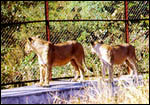Almora, Uttar Pradesh
The Kumaon hill station of Almora is an ordinary enough bustling Himalayan town. But at 1,646 m above sea level nothing appears that ordinary. Blessed with splendid views of the peaks -- Nanda Devi, Kasan Devi, Banari Devi, Trishul... and a tranquillity not found in a number of other mountain resorts, Almora is quite charming.
The town is also one of the few hill stations not set up by the British and that is evident in the layout of the town. Established as a town in the 1500s -- though the Vedas and Puranas indicate that Vishnu once lived here and habitation by people and god people began much earlier -- it lacks the typical Raj hill station flavour, which makes it quite unique.
Its very traditional and picturesque market, with the classic old buildings of wood and stone and ancient temples, is rather atmospheric. The wooden homes -- like in Khazanchi Mohalla -- are embellished with carvings.
The town is spread across a horseshoe-shaped ridge and interestingly the collectorate occupies the highest point within the Almora fort. A sign, near this monument, sums up the history of Almora: "Fort Nanda Devi erected by Chand rajas and strengthened by Gurkha regiment, captured by the British under Colonel Nicholls on 26.4.1815. The convention for the surrender of Kumaon was formed the next day."
The Udyotchandesvar temple honouring Nanda Devi is worth a visit. The bazaar chai stalls offer spicy Indian snacks if you have an iron stomach to match. Do drop in and watch the tamta artisans, copper craftsmen, at work in the bazaar at Tamta Mohalla; their style of craft is over 2,000 years old. Or the Pachmarhi shawl weavers. Almora is also known for its Harris tweed; maybe the only place east of the Suez manufacturing it.
Fast Facts
Sasan Gir National Park, Gujarat
 Gujarat quite literally boils in the summer. Hot winds blow. The earth cracks. And the sun is relentless. But at the Sasan Gir national park -- which spans 1,412 square km of rolling coutryside of Saurashtra -- the weather is a bit better.
Gujarat quite literally boils in the summer. Hot winds blow. The earth cracks. And the sun is relentless. But at the Sasan Gir national park -- which spans 1,412 square km of rolling coutryside of Saurashtra -- the weather is a bit better.
The thinning teak forests are home to a very unsual species -- the Asiatic lion. This royal beast, which once roamed territories as far west as Persia and Arabia, now only has the Gir to call home. But home it is and spotting one of the few hundred animals is not that difficult, especially during one of Gujarat's raging summers, when they can be spied at the waterholes. It is equally easy to spot a range of other animals -- nilgai, hyenas, sambhar, panthers, cheetal, wild pigs, chinkara and crocodiles.
Fast Facts
Jeypore, Orissa



